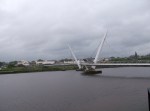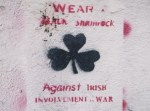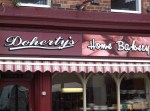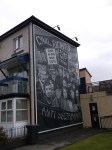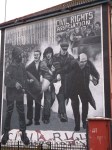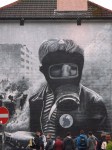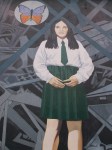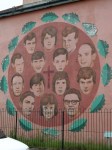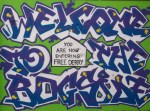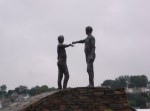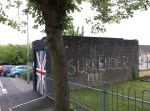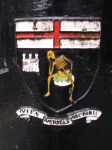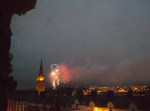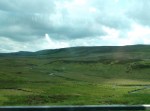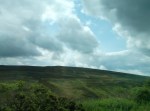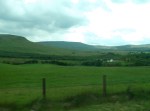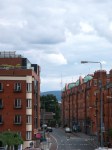First of all Derry must be one of the most underrated cities in Ireland and the British Isles. Though much recognition has come its way. Designated as the UK’s City of Culture with events such as the North Atlantic Fiddle Convention hosted in this city next year. Just today, across the Peace Bridge, Derry hosted a free concert for 10,000 people in cahoots with the One Day for Peace movement culminating soon. OMG! Jude Law!
Needless to say I didn’t go. I was busy wandering the city, and by dinner I was worked. Should rallied and walked across the bridge but couldn’t imagine standing for another three to five hours. Fireworks from my B&B were good enough, pictured below.
I started off receiving a tour of from the Free Derry Museum. If you click the link you may recognize the song these Irish Catholics were singing. Derry is the birthplace of the Troubles so to speak, but its history in connection to the root problem of British-Irish conflict is not recent. In fact, Derry was the first plantation city in Ireland as the English throne sent settlers to build a fort to combat the Spanish and French forces trying to use the North Atlantic as a strategic route to attack their homeland in the 17th C. The Seige of Derry is remembered as an event in which the Unionisst recall their forefathers The Apprentice Boys withstood the onslaught of Catholic King James II in his assertion to the Divine Right of English Kings. This survival of the 100 day long siege from across the River Foyle is still commemorated to this day on July 12 with the marches that I mentioned in my first post.
The Free Derry Museum exists to commemorate the beginning of the Troubles from 1968-1972. The residents of the Bogside (a huge slum of a Catholic majority where the river used to flow in the days of James and the Apprentice Boys) used the cues and examples from the American Civil Rights push to assert their own human rights. Bogsiders were disenfranchised in the city, had little access to jobs and could not own property. In the slum generations of families were forces to live under one roof and squalor. One set of row homes housed 244 in 50 residences! The local police, The Royal Ulster Constabulary force stopped the marches and violence ensued. From there, the Bogside became the powderkeg of the Troubles. Eventually the British Army was brought in to relieve the tension and the RUC. Use the links to connect the dots if you wish.
Initially the locals thought this was the United Nations army to relieve the tensions, but the dark reality set in and the Troubles amped up. The presence of students from across the North flooded Derry to support in peaceful tactics a la American Civil Rights Activists. The wall commemorating the ideal, You Are Now Entering Free Derry, borrowed the slogan from a Berkeley student proclaiming the same.
Tragically, the Bogside is also home to Bloody Sunday. The brother of my tour guide was killed that day running from the Army. This was meant to be a peaceful march followed by speakers by the Free Derry wall. A few protesters decided to try marching into the forbidden route, shots were fired and each victim was killed from a wound in their back. All were running away. None were armed or dangerous. It took until the last few years for the British government to apologize and acknowledge these were in fact murders and not acts of self defense on behalf of the army. This a moving gesture on behalf of David Cameron. The link is a brief video of the speech with footage from Derry and the community’s response. The Saville Inquiryhealed many wounds.
In a more present sense, the Bogside’s deplorable slums were razed and newer more accommodating housing projects were built. Still the walls above the Bogside remained (they still remain if you notice from my pictures), the IRA set up shop in Derry and the British Army presence in Northern Ireland remained until 1998 and the Good Friday Agreement.
Now from my experiences so far, it seems that people of my parents’ generation and those who survived the Troubles acknowledge that things have changed and progress has been made. But I haven’t been able to crack their perspective as to the bridges across communities divides that I wish to find. The people my age, those who lived through the end but not worst of the Troubles, have a deeper perspective on the nature of education and efforts to remedy and remake the community. For many Bogsiders, the pacification of their community is enough and bridges unnecessary.
I then walked up the hill where the walls of the Fort from the Siege of Derry still exist. Around the corner, exists The Fountain, an intentional housing project to integrate Protestant Unionists into the City side of River Foyle during the seventies. They have provocative murals as well and colorful curbs to mark their territory. The communities cannot feel farther apart. The Bogside below, vast and grided. The Fountain tucked away, clean and close to the walls. I hope you find the pictures interesting.
The murals are obviously much different, but the Bogside Artists have been able to communicate the workings of peace in Northern Ireland. Subtle imagery communicates the peace process. I hope you can see the connections. I know I will be using these images in my classroom. At the Free Derry Museum I purchased a book cataloging murals across Northern Ireland, much of which I’ll see in Belfast next week.
The Verbal Arts Center is close to The Fountain and within the Walls. It is a nonprofit supporting Northern Irish literature and creative pursuits. They have a great library dedicated to Irish publishing houses. I talked to resident artist David Campbell who is a comic book/graphic novel artist. He provided me with some great resources and an example of art curriculum to bridge the youth divide. Celtic and Rangers are Scottish football clubs. You either love them or hate them depending on your religious, political stances. Very intriguing model. I purchased Stories in Conflict and Peace and Reconciliation Worksheets for Facilitators to use directly in my Borders curriculum next semester. Super excited by these.
Finally I stumbled into a community office that I forget the name of. Just dropped in and grabbed a booklet of the Sure What’s the Problem Community Relations Week for May of 2011 in Derry. Impressive curriculum for the entire community to dialogue and create new directions for the bridging divides. Such classes included: A Flag Audit of Households, Ethical and Shared Remembering, Screening Histories of the Conflict, Football for All, and the Launch of a Garden of Reflection to name a few. Impressive community building.
Derry is an unbelievable gem. It is only fitting that I began my research with this city. It is also fitting that I stumbled upon it, gathered steam with a chance encounter on a train to Belfast and culminates sooner than it should. This is a must visit city. Brilliant!
The Angel House has been a welcoming haven for me. Located just above the Bogside, eye level with the Walls if you will, this family has been great with advice, generosity and compassion. Cheers!
Tomorrow I head to Strabane, twenty minutes south. This is a border town that saw its share of the Troubles. No one in this city can imagine why I am headed there instead of staying in Derry. But I am going to connect with the family of Aidan McLaughlin, whom we hosted through Project Children. We have never met his parents. I’ll meet his niece and nehpew tomorrow as well. Greatly excited.
Keep in mind today was really the first true day of my hands on ethnography. I could’ve written another four blog posts about it. Whew. Thanks Fund For Teachers!


